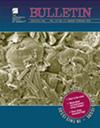中生代陆地古生态学的生物地球化学新见解和三齿龙杂食性的证据
IF 3.9
1区 地球科学
Q1 GEOSCIENCES, MULTIDISCIPLINARY
引用次数: 0
摘要
北美洲白垩纪古群落保留了丰富的生物多样性记录,表明与现生系统中的生态对应物相比,许多物种占据了狭窄的生物地理范围。仅从化石中很难确定这些系统中的类群是如何划分其生态位和构建其群落的,这导致了有关饮食和栖息地利用的各种假说。在这里,我们研究了从加拿大阿尔伯塔省奥德曼地层的一个时空限制区间取样的一系列共生脊椎动物类群的珐琅质中的元素比率(Sr/Ca、Ba/Ca),以重建营养结构,并利用δ13C、δ18O和87Sr/86Sr成分来检验巨齿龙、角龙和踝龙之间的生态位划分和栖息地利用情况。我们还检验了之前提出的有蹄类食性假说。 在大型鸟臀目动物中,我们发现Ba/Ca和Sr/Ca比率与草食性一致,黑角龙在87Sr/86Sr范围上有别于角龙和踝龙,这种模式表明了栖息地利用/广度、食物植物来源和进食高度的差异。取样的哺乳动物、变齿蜥形类、单脊龙类和暴龙类的 Sr/Ca 和 Ba/Ca 比率保持着较低的梯度,这与动物为主的杂食性到动物为主的食性是一致的。齿龙类由于其独特和不寻常的牙齿而被假定为兽食性、杂食性或草食性,它们所保留的Sr/Ca和Ba/Ca比率介于鸟臀类和单齿龙类之间。从这些多代数据中,我们可以将套齿龙类解释为混食植物到植物为主的杂食动物。这些代用指标是了解白垩纪生态系统营养和群落生态学的重要工具,为未来的古生物学研究提供了巨大的潜力。本文章由计算机程序翻译,如有差异,请以英文原文为准。
New biogeochemical insights into Mesozoic terrestrial paleoecology and evidence for omnivory in troodontid dinosaurs
The Cretaceous paleocommunities of North America preserve a rich record of biodiversity that suggests many species occupied narrow biogeographic ranges in comparison to their ecological equivalents in extant systems. How taxa in these systems partitioned their niches and structured their communities can be difficult to determine from fossils alone, which has led to a variety of hypotheses concerning diets and habitat use. Here, we examine element ratios (Sr/Ca, Ba/Ca) in the enamel of a suite of co-occurring vertebrate taxa sampled from a spatiotemporally constrained interval in the Oldman Formation of Alberta, Canada, to reconstruct trophic structure, and use δ13C, δ18O, and 87Sr/86Sr compositions to test for niche partitioning and habitat use among hadrosaurids, ceratopsids, and ankylosaurs. We also test previously proposed dietary hypotheses of troodontid theropods. In large ornithischians, we find Ba/Ca and Sr/Ca ratios that are consistent with herbivory, with hadrosaurs distinct from ceratopsids and ankylosaurids in their 87Sr/86Sr ranges, a pattern that is indicative of differences in habitat use/breadth, dietary plant sources, and feeding height. The sampled mammals, varanoid lizards, dromaeosaurids, and tyrannosaurids preserve a gradient of lower Sr/Ca and Ba/Ca ratios that is consistent with animal-dominant omnivorous to faunivorous diets. Troodontids, which have been variably hypothesized as either faunivorous, omnivorous, or herbivorous due to their distinct and unusual dentition, preserve Sr/Ca and Ba/Ca ratios that fall between those of the ornithischians and the dromaeosaurids. From these multi-proxy data, we interpret troodontids as mixed-feeding to plant-dominant omnivores. These proxies represent a valuable tool for understanding the trophic and community ecology of Cretaceous ecosystems and hold enormous potential for future research in paleobiology.
求助全文
通过发布文献求助,成功后即可免费获取论文全文。
去求助
来源期刊

Geological Society of America Bulletin
地学-地球科学综合
CiteScore
9.30
自引率
8.20%
发文量
159
审稿时长
4-8 weeks
期刊介绍:
The GSA Bulletin is the Society''s premier scholarly journal, published continuously since 1890. Its first editor was William John (WJ) McGee, who was responsible for establishing much of its original style and format. Fully refereed, each bimonthly issue includes 16-20 papers focusing on the most definitive, timely, and classic-style research in all earth-science disciplines. The Bulletin welcomes most contributions that are data-rich, mature studies of broad interest (i.e., of interest to more than one sub-discipline of earth science) and of lasting, archival quality. These include (but are not limited to) studies related to tectonics, structural geology, geochemistry, geophysics, hydrogeology, marine geology, paleoclimatology, planetary geology, quaternary geology/geomorphology, sedimentary geology, stratigraphy, and volcanology. The journal is committed to further developing both the scope of its content and its international profile so that it publishes the most current earth science research that will be of wide interest to geoscientists.
 求助内容:
求助内容: 应助结果提醒方式:
应助结果提醒方式:


